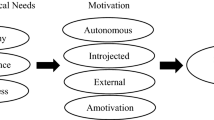Abstract
Within the framework of cognitive motivation theory, selected personal and environmental motivational variables for faculty in eight liberal arts and science departments from community colleges, liberal arts colleges, comprehensive colleges and universities, and research universities were regressed against faculty allocation of work effort given to research, scholarship, and service. The data came from a 1988 national survey of faculty.Gender, (sociodemographic), quality of graduate school attended, career age, andrank (career); self-competence andself-efficacy regarding research, scholarship, and service andpercent time prefer to give to research, scholarship, and service (self-valuations); andinstitutional preference, consensus andsupport, andcolleague commitment to research, scholarship, and service (perception of the environment) were entered into regressions.R 2s were generally strong (.64 for liberal arts-I institutions) and significant. For all institutional types,self-valuation (self-competence and-efficacy) motivators significantly accounted for the explained variance.Sociodemographic andcareer variables did not explain appreciable amounts of variance.
Similar content being viewed by others
References
Allison, P. D., and Stewart, J. A. (1974). Productivity differences among scientists: Evidence for accumulative advantage.American Sociological Review 39(4): 596–606.
Astin, H. S. (1978). Factors affecting women's scholarly productivity. In Helen S. Astin and Werner Z. Hirsch (eds.),The Higher Education of Women, pp. 133–157. New York: Praeger.
Astin, H. S. (1984). Academic scholarship and its rewards. In M. W. Steinkamp and M. Maeher (eds.),Advances in Motivation and Achievement, vol. 1. JAI Press, pp. 259–279.
Baldwin, R. G., and Blackburn, R. T. (1981). The academic career as a developmental process: Implications for higher education.Journal of Higher Education 52(6): 598–614.
Bandura, A. (1977). Self-efficacy: Toward a unifying theory of behavioral science.Psychological Review 84(2):191–215.
Bentley, R. J., and Blackburn, R. T. (November 1990). Relationship of faculty publication performance with age, career age, and rank. Paper presented at the annual meeting of the Association for the Study of Higher Education, Portland, OR.
Blackburn, R. T., Boberg, A., O'Connell, C., and Pellino, G. R. (1980).Project for Faculty Development Program Evaluation. Ann Arbor: University of Michigan, Center for the Study of Higher Education.
Blackburn, R. T., and Lawrence, J. H. (1986). Aging and the quality of faculty performance.Review of Education Research 23(3): 265–290.
Blackburn, R. T., Lawrence, J. H., Bieber, J. P., and Trautvetter, L. C. (1991). Faculty at work: Focus on teaching.Research in Higher Education (in press).
Blackburn, R. T., and Mackie, C. (1990).Test-Retest Reliability Coefficients: Faculty at Work. Ann Arbor: University of Michigan, NCRIPTAL.
Boyer, C. M., and Lewis, D. R. (1985).And on the Seventh Day: Faculty Consulting and Supplemental Income. AAHE-ERIC Higher Education Report No. 4. Washington, DC: Association for the Study of Higher Education.
Breneman, D. W., and Youn, I. K. (1988).Academic Labor Markets and Careers. New York: Palmer Press.
Carnegie Foundation for the Advancement of Teaching (July 8, 1987). A classification of institutions of higher education.Chronicle of Higher Education 33(43): 22–30.
Carnegie Foundation for the Advancement of Teaching (1989).1989 National Survey of Faculty Data. Princeton, NJ: Carnegie Foundation.
Clark, M. J., and Centra, J. A. (1985). Influences on the career accomplishments of Ph.D.'s.Research in Higher Education 23(3): 256–259.
Finkelstein, M. J. (1984).The American Academic Profession: A Synthesis of the Social Scientific Inquiry Since World War II. Columbus: Ohio State University Press.
Gilligan, C. (1982).In a Different Voice. Cambridge, MA: Harvard University Press.
Ladd, E. C., and Lipset, S. M. (1975).Technical Report—1975 Survey of the American Professoriate. Storrs: University of Connecticut, The Social Science Data Center.
Landino, R. A., and Owen, S. V. (1988). Self-efficacy in university faculty.Journal of Vocational Behavior 33: 1–14.
Lawrence, J. H., and Blackburn, R. T. (1985). Faculty careers: Maturation, demographic, and historical effects.Research in Higher Education 22(2): 135–154.
Schoen, L. G., and Winocur, S. (1988). An investigation of the self-efficacy of male and female academics.Journal of Vocational Behavior 32: 307–320.
Staw, B. B. (1984). Motivation research versus the art of faculty management. In J. L. Bess (ed.), pp. 63–83.College and University Organization: Insights from the Behavioral Sciences. New York: NYU Press.
Tuckman, H. P., and Leahey, J. (1975). What is an article worth?Journal of Political Economy 83(5): 951–967.
Author information
Authors and Affiliations
Rights and permissions
About this article
Cite this article
Blackburn, R.T., Bieber, J.P., Lawrence, J.H. et al. Faculty at work: Focus on research, scholarship, and service. Res High Educ 32, 385–413 (1991). https://doi.org/10.1007/BF00992183
Received:
Issue Date:
DOI: https://doi.org/10.1007/BF00992183




